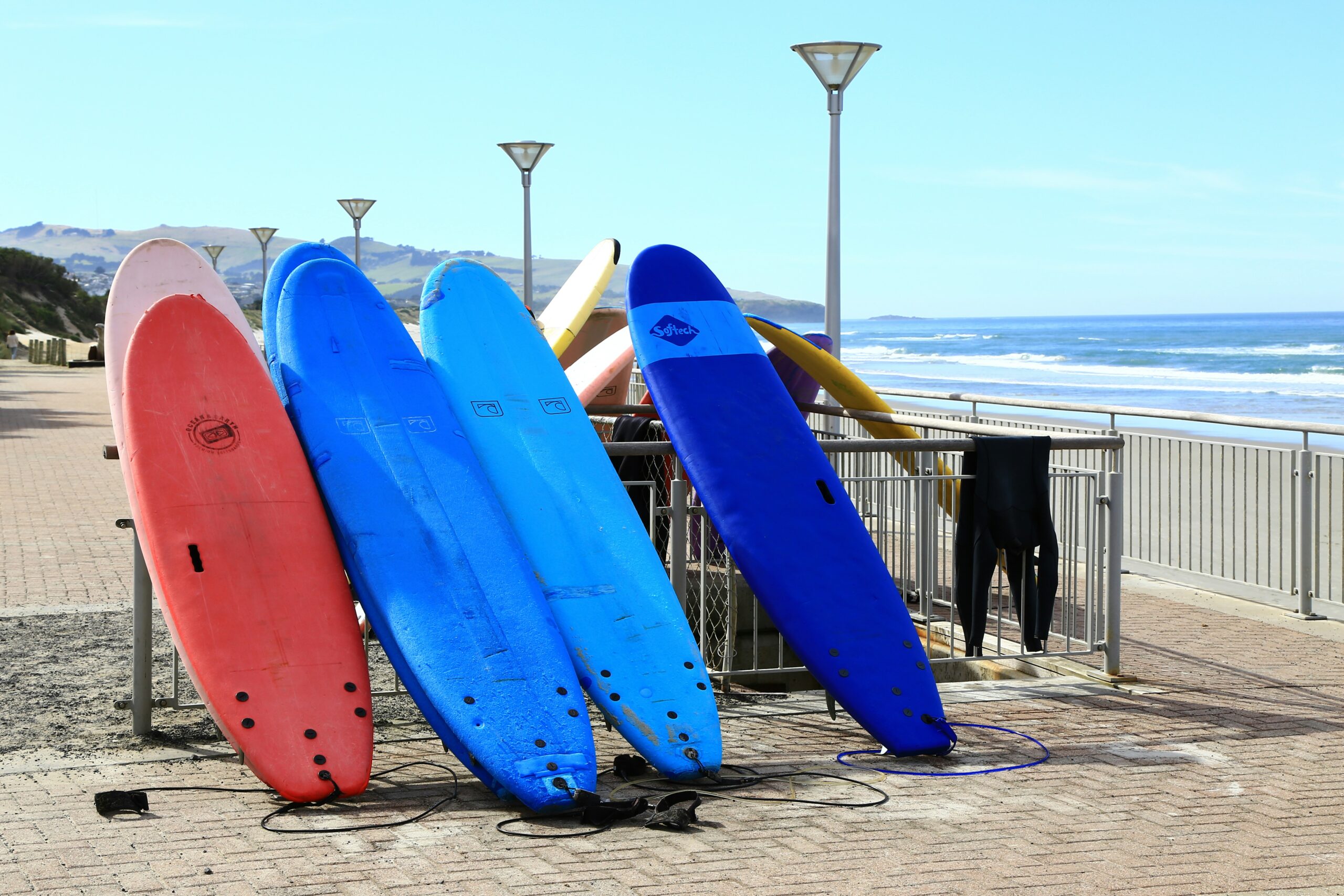Surfing is more than just a sport; it’s a lifestyle. Whether you’re a seasoned pro or a beginner catching your first wave, one of the most crucial decisions you’ll make is choosing the right surfboard. Among the myriad factors to consider, the material of your surfboard plays a significant role in your surfing experience.
In this guide, we’ll delve into the various materials used in crafting surfboards and help you determine which is best suited for your needs.
Understanding Surfboard Materials:
Surfboards are crafted from a variety of materials, each with its unique characteristics affecting performance, durability, and cost. Let’s explore some of the most common materials:
- Polyurethane (PU) Foam:
- PU foam has long been the standard material for surfboard cores. It’s lightweight, provides excellent buoyancy, and offers a familiar feel to most surfers.
- Traditional fiberglass cloth is laminated over the PU foam core, providing strength and durability.
- PU boards are known for their responsiveness and versatility, making them suitable for a wide range of wave conditions.
- Expanded Polystyrene (EPS) Foam:
- EPS foam is lighter and more buoyant than PU foam, making it ideal for beginners or surfers looking for extra flotation.
- EPS boards are often laminated with epoxy resin, which enhances durability and strength.
- These boards are known for their buoyancy and ease of paddling, making them suitable for smaller or weaker waves.
- Epoxy:
- Epoxy resin is used in conjunction with various foam cores, including EPS and extruded polystyrene (XPS).
- Epoxy boards are lauded for their durability and resistance to dings and dents.
- They tend to be lighter and more buoyant than traditional PU boards, offering enhanced performance in smaller waves.
Choosing the Right Surfboard Material:
Now that you’re familiar with the primary surfboard materials, how do you decide which one is best for you? Consider the following factors:
- Skill Level:
- Beginners may benefit from the buoyancy and stability offered by EPS or epoxy boards.
- Advanced surfers might prefer the responsiveness and feel of traditional PU boards.
- Wave Conditions:
- If you predominantly surf in smaller or weaker waves, EPS or epoxy boards may provide the extra buoyancy needed to catch and ride waves effectively.
- For larger or more powerful waves, PU boards offer the control and responsiveness necessary for critical maneuvers.
- Durability:
- If you’re prone to dinging or damaging your board, epoxy boards are more resistant to such wear and tear compared to traditional PU boards.
- Budget:
- Consider your budget when selecting a surfboard material. Epoxy boards tend to be more expensive upfront but may offer long-term savings due to their durability.
In the world of surfing, the choice of surfboard material can significantly impact your performance and enjoyment on the waves. Whether you opt for the classic feel of a PU board or the lightweight buoyancy of an EPS or epoxy board, understanding the characteristics of each material is essential in making an informed decision.
A detailed comparison of the materials commonly used in crafting surfing boards
- Polyurethane (PU) Foam:
- Core Material: PU foam has been the traditional choice for surfboard cores for decades. It’s made by reacting diisocyanates with polyols to create a rigid foam material.
- Characteristics:
- Density: PU foam tends to have a higher density compared to EPS foam, resulting in a slightly heavier board.
- Flex: PU boards typically offer a good balance of flex and stiffness, providing a familiar feel to most surfers.
- Responsiveness: They are known for their responsiveness, offering excellent control and maneuverability on the waves.
- Repairability: PU boards are relatively easy to repair, as traditional fiberglass cloth can be easily laminated over the foam core.
- Ideal Conditions: PU boards excel in a wide range of wave conditions, making them a versatile choice for surfers of all levels.
- Durability: While PU boards are durable, they may be more prone to dings and dents compared to epoxy boards.
- Expanded Polystyrene (EPS) Foam:
- Core Material: EPS foam is a lightweight, closed-cell foam material known for its excellent buoyancy.
- Characteristics:
- Buoyancy: EPS foam offers superior buoyancy compared to PU foam, making it easier to paddle and catch waves, especially for beginners.
- Weight: EPS boards tend to be lighter than PU boards, which can be advantageous for transportation and maneuverability in the water.
- Durability: EPS foam is less prone to water absorption, reducing the risk of delamination and rot over time.
- Flex: EPS boards may have a slightly different flex pattern compared to PU boards, offering a unique feel on the waves.
- Ideal Conditions: EPS boards are well-suited for smaller or weaker waves where extra flotation is beneficial.
- Repairability: While EPS boards are durable, repairs may require specific materials and techniques due to the use of epoxy resin in lamination.
- Epoxy:
- Lamination Material: Epoxy resin is a type of thermosetting polymer that offers exceptional strength and durability.
- Characteristics:
- Strength: Epoxy boards are renowned for their durability and resistance to dings, dents, and yellowing over time.
- Weight: Epoxy boards tend to be lighter than traditional PU boards, providing enhanced buoyancy and maneuverability.
- Flex: Epoxy boards may offer a slightly different flex pattern compared to PU boards, with some surfers preferring the livelier feel.
- Environmental Impact: Epoxy resin is generally considered more environmentally friendly than polyester resin used in PU boards.
- Ideal Conditions: Epoxy boards perform well in a variety of wave conditions, offering a good balance of performance and durability.
- Repairability: Epoxy boards are relatively easy to repair, with epoxy resin readily bonding to damaged areas for seamless fixes.
In summary, each surfboard material offers its unique characteristics, catering to different preferences and surfing styles. Whether you prioritize responsiveness, buoyancy, durability, or environmental impact, understanding the differences between PU foam, EPS foam, and epoxy can help you make an informed decision when choosing your next surfing board.
Consider your skill level, wave conditions, durability requirements, and budget when choosing the perfect surfboard material for your next ride. With the right board beneath your feet, you’ll be carving up the waves in style.











